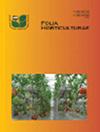Byrsonima crassifolia L. Kunth a bio-resource with potential: Overview and opportunities
IF 1.8
4区 农林科学
Q2 HORTICULTURE
引用次数: 0
Abstract
ABSTRACT Byrsonima crassifolia L. Kunth is a plant native to the Americas that grows in tropical and subtropical areas. Fresh B. crassifolia fruits are a good source of ascorbic acid and carotenoids and contain volatile compounds such as butyric and caproic acids. Although B. crassifolia is commonly exploited from wild natural ecosystems, it exhibits the potential to become a crop plant. When optimal agronomic management systems support propagation by seed, fruits with more homogeneous characteristics can be produced compared to those obtained from wild or backyard plants. B. crassifolia fruits can be found in local markets in Central and South America. The pulp, peel, and other B. crassifolia fruit components can be processed to make traditional and innovative food products, namely candies, cookies, cakes, candied fruits, ice creams, sorbets, jellies, juices, liqueurs, jams, nectars, pickles, and fruit drinks as an alternative to avoid the waste of overripe fruits. Additionally, the woody fraction of the B. crassifolia tree is used as a source of firewood, as shade, and for constructing living fences. These uses also allow the maximum use of biomass by establishing support for cultivation with the circular economy and strengthening food security. Therefore, this review aims to provide insights into the generation and dissemination of knowledge supporting the development of strategies in the areas of agronomy, postharvest management, and technological processing of B. crassifolia to promote its sustainable use and exploitation.具有潜力的生物资源:综述与机遇
摘要:厚叶Byrsonima crassifolia L.Kunth是一种原产于美洲的植物,生长在热带和亚热带地区。新鲜的厚叶B.crassifolia果实是抗坏血酸和类胡萝卜素的良好来源,含有丁酸和己酸等挥发性化合物。尽管青海B.crassifolia通常是从野生自然生态系统中开发的,但它显示出成为作物的潜力。当最佳农艺管理系统支持种子繁殖时,与野生或后院植物相比,可以生产出具有更均匀特性的果实。在中美洲和南美洲的当地市场上都可以找到青海树果实。可以将果肉、果皮和其他厚叶B.crassifolia水果成分加工成传统和创新的食品,即糖果、饼干、蛋糕、蜜糖水果、冰淇淋、冰糕、果冻、果汁、利口酒、果酱、油桃、泡菜和水果饮料,作为避免浪费过熟水果的替代品。此外,厚叶B.crassifolia树的木质部分被用作木柴、树荫和建造生活围栏的来源。这些用途还通过支持循环经济种植和加强粮食安全,最大限度地利用生物质。因此,本综述旨在为知识的产生和传播提供见解,支持厚叶B.crassifolia在农学、采后管理和技术加工领域制定战略,以促进其可持续利用和开发。
本文章由计算机程序翻译,如有差异,请以英文原文为准。
求助全文
约1分钟内获得全文
求助全文
来源期刊

Folia Horticulturae
Agricultural and Biological Sciences-Horticulture
CiteScore
3.40
自引率
0.00%
发文量
13
审稿时长
16 weeks
期刊介绍:
Folia Horticulturae is an international, scientific journal published in English. It covers a broad research spectrum of aspects related to horticultural science that are of interest to a wide scientific community and have an impact on progress in both basic and applied research carried out with the use of horticultural crops and their products. The journal’s aim is to disseminate recent findings and serve as a forum for presenting views as well as for discussing important problems and prospects of modern horticulture, particularly in relation to sustainable production of high yield and quality of horticultural products, including their impact on human health.
 求助内容:
求助内容: 应助结果提醒方式:
应助结果提醒方式:


